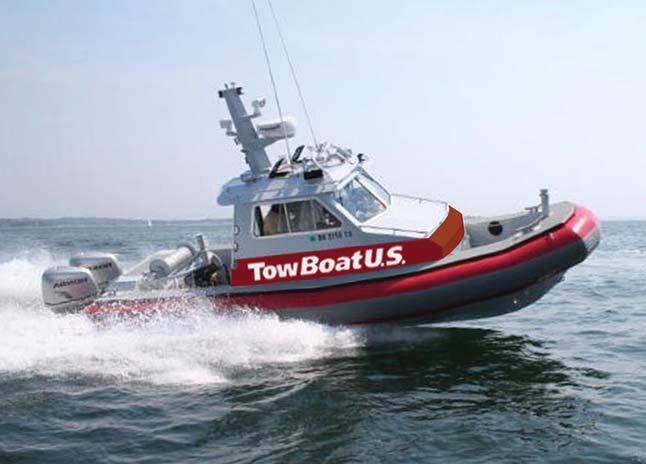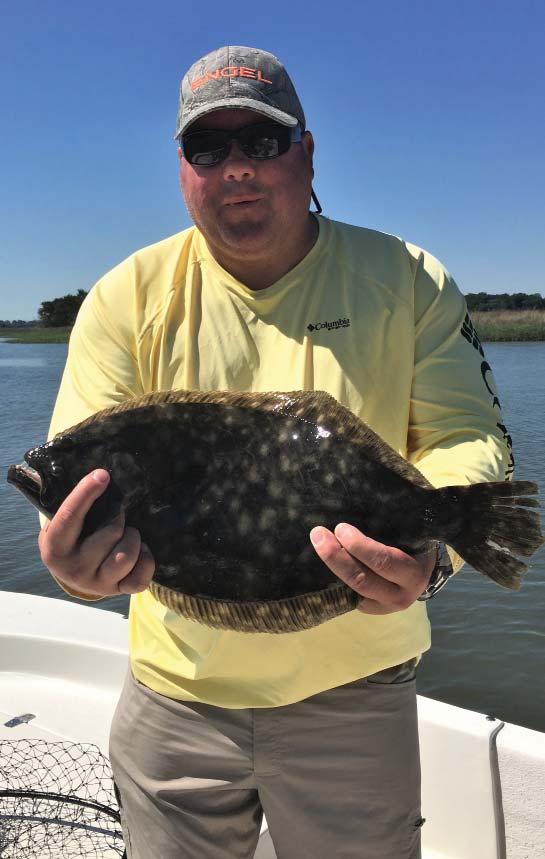
20 minute read
9 Ebb & Flow
Summertime
By Trey Leggett
Advertisement
It’s that time again. That magical time when the kids are out of school, any kind of water activity is welcomed, shorts and fl ip fl ops are everyday wear, and some of the best fi shing happens. But it’s also the time when some of the worst weather can creep up on us. Let’s briefl y talk about keeping yourself and your boat protected and then what great fi shing is available during these hot months.
Hopefully everyone has a hurricane plan in place. You know, a place for you and the kids to go inland, making sure to remember your insurance and other important documents, pictures, jewelry, etc. What about a plan for your boat? Many folks I’ve talked with will leave their boat in dry storage at the marina or leave it on a trailer at the house. Many in my neighborhood will leave it on the trailer in an open fi eld so trees or tree branches can’t cause damage. Of course, if you have a larger boat you can anchor in a safe place in the water with moorings, but I’d suggest reading up on the best ways of doing this fi rst. Although it could present challenges due to heavy traffi c, taking your boat with you during an evacuation is also an option if you leave early enough. The last couple of storms we’ve had left many improperly stored boats on roadways, in marshes, or lost. This isn’t good for our ecosystem since these boats usually start leaking fuel and oil eventually or do so during the recovery process. But whatever your course of action, start planning now.
Now on to fi shing. Summertime fi shing in the lowcountry brings a wide variety of fi shing opportunities for the beginner on up to the advanced fi sherman. You can catch fi sh from the beach, a pier, a dock, a boat, or a kayak. The fi rst fi sh that comes to mind is fl ounder. We have both the summer fl ounder and southern fl ounder species in our area and both taste good!
The easiest way to catch fl ounder is to use a bottom weighted rig, baited with shrimp or mud minnows. Of course, you can catch the ever-favorite redfi sh and speckled trout during the summer, in the same areas and same manner as other months.
Boat or kayak anglers can go beachside and troll for Spanish mackerel. Spanish mackerel are a tasty dark meat fi sh that put up a fun fi ght on rod and reel for adults and kids.
More experienced anglers can try their hand at tarpon fi shing. Although you can’t keep tarpon, they're a fi sherman’s dream hen it comes to wrangling and landing such a strong and acrobatic fi ghter. You are likely to fi nd tarpon more in July and August near inlets. Use medium to heavy tackle with a thick leader to get the tarpon landed in a reasonable amount of time so the fi sh doesn’t get too tired out and can’t revive. Be careful of those gill plates, they are razor sharp! Use gloves whenever handling any portion of
Trey with a great fl ounder catch! Photo by Austin Leggett
the tarpon’s head or mouth.
Last but certainly not least, a variety of sharks can be caught from the beach, pier, or boat. Sharks are fun to catch, and they put up a nice battle trying to get them in. Watch out for those teeth! Even the little ones will get hold of you if you give them the opportunity.
As always, think ahead and plan so you don’t fi nd yourself in a pickle. Check your state’s fi shing regulations to ensure you’re compliant. Have a great summer and stay hydrated.
Stay safe and tight lines!
Trey fi shes for Hobie Polarized Sunglasses, and ENGEL Coolers. Email: info@southerntidesmagazine.com
By Laura Weyman
Communications Intern Gray’s Reef National Marine Sanctuary
Since 2002, June 8 has been recognized 2, June 8 has been recognized globally as World Ocean Day. Hundreds orld Ocean Day. Hundreds of organizations, including the ions, including the National Oceanic and Atmospheric anic and Atmospheric Administration (NOAA), reach out (NOAA), reach out in an eff ort to educate and inspire educate and inspire the public to become ocean o become ocean stewards. Various events are ious events are off ered worldwide, ranging from ide, ranging from beach clean-ups and fundraising s and fundraising marathons to fi lm screenings fi lm screenings and more.
Each year, World Ocean World Ocean Day incorporates a diff erent ates a diff erent theme. In 2017, it was “Our 17, it was “Our oceans, our future” and this future” and this year, the conversation was about rsation was about plastic pollution and encouraging n and encouraging solutions for a healthy ocean. healthy ocean.
Plastic is versatile, durable and ersatile, durable and extremely aff ordable, which has led rdable, which has led to it becoming one of the most widely one of the most widely used materials in the world. From water in the world. From water bottles to clothing, plastic is all around us hing, plastic is all around us and often hides in objects that might surprise us. in objects that might surprise us. Trying to avoid it has become nearly impossible, and ithasbecomenearl impossibleand disposing of it is even trickier. Much of the world’s plastic ends up in waterways and eventually fi nds its way to the ocean.
How can you help? The best thing is to continue implementing the three Rs: Reduce, Reuse and Recycle. Every little bit matters. Also, make sure you always dispose of waste properly. Make a point of staying informed, and help inform others. A great resource is NOAA’s marine debris website: marinedebris.noaa.gov.
But what about one of the biggest challenges regarding plastic

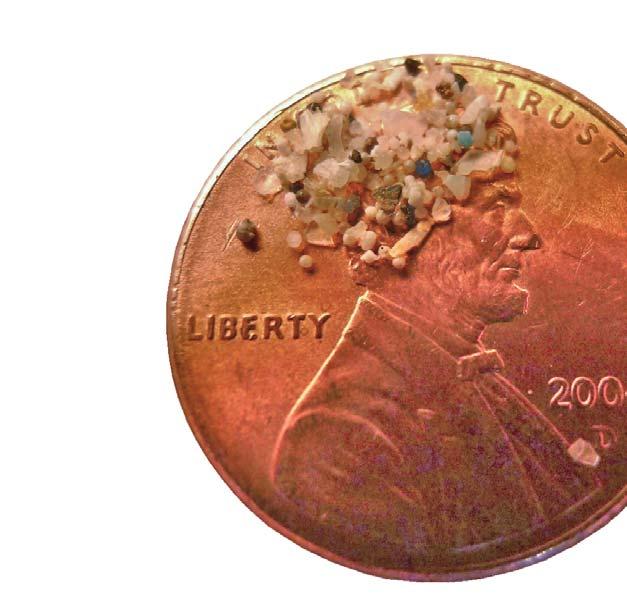
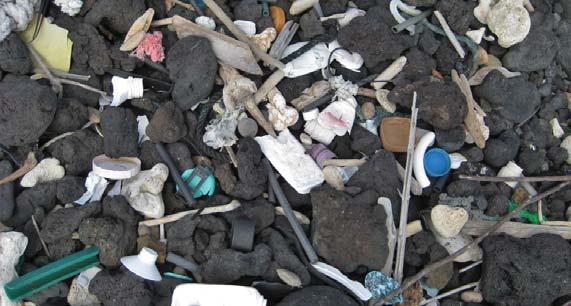
Above: Plastic marine debris. Photo provided by NOAA Inset: Microplastics mixed with sand on a penny. Photo by 5gyres.org
pollution, one that can’t be captured by a camera pollution, one that can’t be capture nor spotted by the naked eye? I’m speaking nor spotted by the naked eye? of microplastic, which NOAA defi nes as of microplastic, which NOA plastic debris less than fi ve millimeters plastic debris less than fiv long. Due to its virtually indestructible long. Due to its virtually nature, plastic does not decompose. It nature, plastic does not simply breaks down into smaller and simply breaks down int smaller particles until they become smaller particles until microscopic. When plastic reaches microscopic. When p that size, no creature can avoid that size, no creatu ingesting it. In the ocean, small fi sh ingesting it. In the oc swallow microplastic, and then swallow microplast bigger fi sh eat those small fi sh, and bigger fi sh eat those so on. The plastic makes its way all so on. The plastic ma the way up the food chain until it the way up the food reaches us in microscopic particles reaches us in microsc within the fatty parts of fi sh we like within the fatty parts to eat. to eat. Cleaning up existing microplastic Cleaning up existin is not feasible, but preventing bigger is not feasible, but prev pieces of plastic from entering our ocean pieces of plastic from enter is. Organized beach cleanups are eff ective, is. Organized beach cleanup as are daily actions that make a positive as are daily actions that ma impact. More and more people have stopped impact. More and more people using plastic straws, have started bringing their own using plastic straws, have started bring mugs to coff ee shops, and no longer use plastic bags to stow mu t ff hp ndn ln ru pl ti fruit and other produce in their grocery carts. Reusable shopping bags are seen everywhere these days, and many people keep eating utensils handy so they don’t need a plastic fork when ordering take out.
It’s not too late to start and every day counts! Help keep our ocean clean so we can continue to fi sh, dive, swim, kayak and otherwise enjoy the wide range of benefi ts it off ers us.
For more information, email michelle.riley@noaa.gov or call (912) 598-2345
Beer can and plastic pitcher found at Gray's Reef. Photos provided by GRNMS
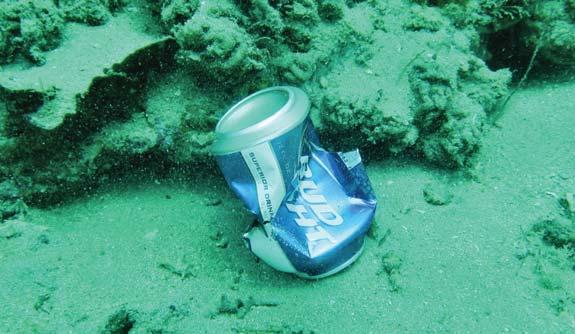
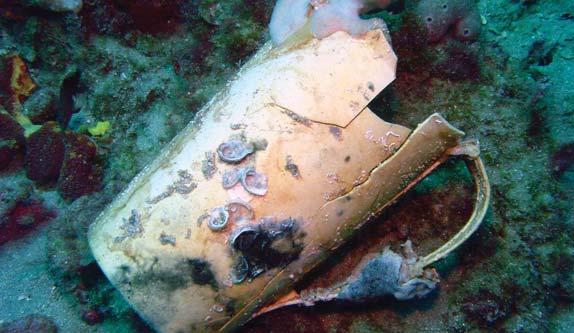
Did You Know? Taste of the Tides
The sex of loggerhead sea turtle hatchlings is determined by temperatures in the nest. Warmer conditions will result in mostly females, while cooler temps will result in mostly males.
Asian Salmon Baked in Foil
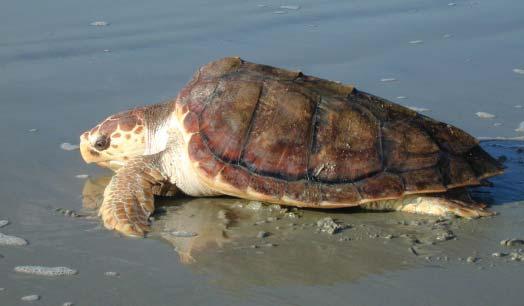
• Females will nest every two to three years, returning to their “natal beach” where they hatched. She will nest an average of five times per season, laying around 115 eggs per nest. The eggs will hatch after about 60 days. • Some credit the name "loggerhead" to the turtle's heads resembling large logs, while others credit the name to the fact that their heads are so large in comparison to their bodies. • Loggerhead sea turtles (Caretta caretta) nest in temperate zones around the world while most other sea turtles nest only in tropical zones. They're also the most common species found in Georgia and South Carolina waters. • The loggerhead’s carapace (shell) averages three feet in length, and they can weigh from 150 to 400 pounds. • The greatest dangers to loggerheads (and all sea turtles) are boat strikes, entanglement in commercial fishing gear, and consuming trash mistaken for food, which can all prove fatal. Other negative impacts include loss of nesting beaches and lights on land that can disorient the nesting turtles and emerging hatchlings. • For data on nesting season in Georgia and South Carolina, and elsewhere in the world, visit www.seaturtle.org/nestdb/
Photo above, a female returning to the water after nesting. Below, an emerging hatchling making its way hrough the sand. Photos provided by GADNR
By Chef Johnny Carino Owner, Fresh 2 You Brunswick, Georgia
Any fi sh can be substituted if you prefer something other than salmon. You can also try this recipe on the grill, just cook it 10 minutes longer.
INGREDIENTS
4 salmon filets 2 teaspoons honey ¼ cup cilantro ¹/8 cup lite soy sauce 1 tablespoon sliced ginger 1 tablespoon olive oil 1 tablespoon shaved garlic Sea salt and pepper to taste
DIRECTIONS
•Preheat oven to 350° •Season salmon on both sides with sea salt and pepper. •Mix remaining ingredients in a small mixing bowl. •Place each salmon fi let on a piece of foil large enough to seal around the fi sh. •Spoon or brush the honey/soy mixture onto each fi let •Seal the foil, crimping the edges to prevent drips •Bake at 350° •Use caution removing from oven. Allow salmon to rest for two minutes before opening.
Enjoy!
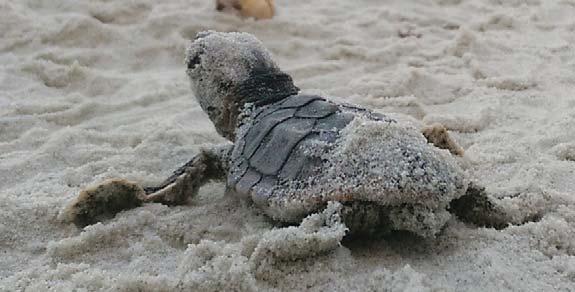

A Walk on the Wild Side
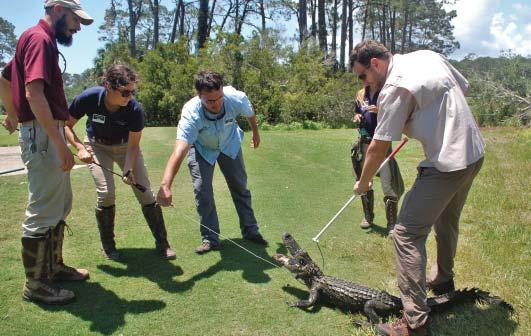
One of the most misunderstood species inhabiting our before the dog expects to be fed, and alligators will learn just as quickly.” Aside from the danger to humans attempting to feed these stretch of coast, the American alligator (Alligator mississippiensis), is regarded by some with fascination and by others with fear, even though attacks are rare. Falling into the fascination category, I was thrilled to be invited to ride along on an alligator mark and recapture trip on Jekyll Island recently.
I met with Joseph Colbert, wildlife manager for the Jekyll Island Authority (JIA), and his team, on a sunny May morning and we set out in search of these huge, prehistoric-looking reptiles. At our fi rst stop, a lagoon on a golf course, Joseph explained what we would be doing that day.
The monitoring program began in 2011 in an eff ort to better understand the island’s alligator population, including numbers, how many there are in each size category, or class size, and their habitats. Each month during warm weather, Joseph and his team perform surveys of the island’s fresh water ponds and lagoons. Step one is a daytime census count in which the team observes alligators with binoculars, which gives them a good idea of class size estimations. Step two is a nighttime census count, when more alligators are present, in which a spotlight is used to detect eyeshine. The team can use the eye-shine to determine skull size, and therefore overall length of the gators. These two counts together provide a good estimation of population numbers and size classes. Step three is mark and recapture, during which the team captures as many alligators as they can to take measurements, tissue samples for DNA and toxicology, and tag any that haven’t already been tagged. The numbers from all three steps provide an understanding of the “minimum known alive” population of alligators three feet in length or longer.
As Joseph and I sat on a nearby bench and chatted, land conservation manager Yank Moore, UGA graduate student Rick Bauer, and AmeriCorps Conservation member Alec Jarboe attempted to capture one of several small alligators they’d encountered on the previous day’s census count. As we sat chatting and watching, I notice a nearby sign warning against feeding the gators. By Amy Thurman “People feeding alligators is a huge problem,” Joseph explained. “It’s kind of like giving dinner scraps to a dog. It doesn’t take long wild animals, this also presents a threat to the alligators. Most gators will instinctively avoid human contact and stay away from populated areas, but when they learn to beg, they lose their fear of humans and are less likely to avoid areas where people congregate. Many coastal areas employ alligator trappers who are called for removal when an alligator is spotted in a populated area, and in many cases this involves the alligator being put down. Jekyll Island has a non-removal policy in place. When a gator does turn up in a crowded area, Joseph and his team use the data they collect during these monthly surveys to determine which alligator it is, where it was last seen and where it may have been attempting to go. With this information, they'll then try to move it to its intended destination. The non-removal policy could be reconsidered if people feeding alligators continues to be a problem. Our fi rst gator of the morning was in another small pond near the golf course. Everyone was excited as we watched Rick reel the gator to the bank while Yank and Alec stood by ready to haul it in. Once the gator was on solid ground, everyone worked quickly. The gator’s mouth was closed and secured with electrical tape,
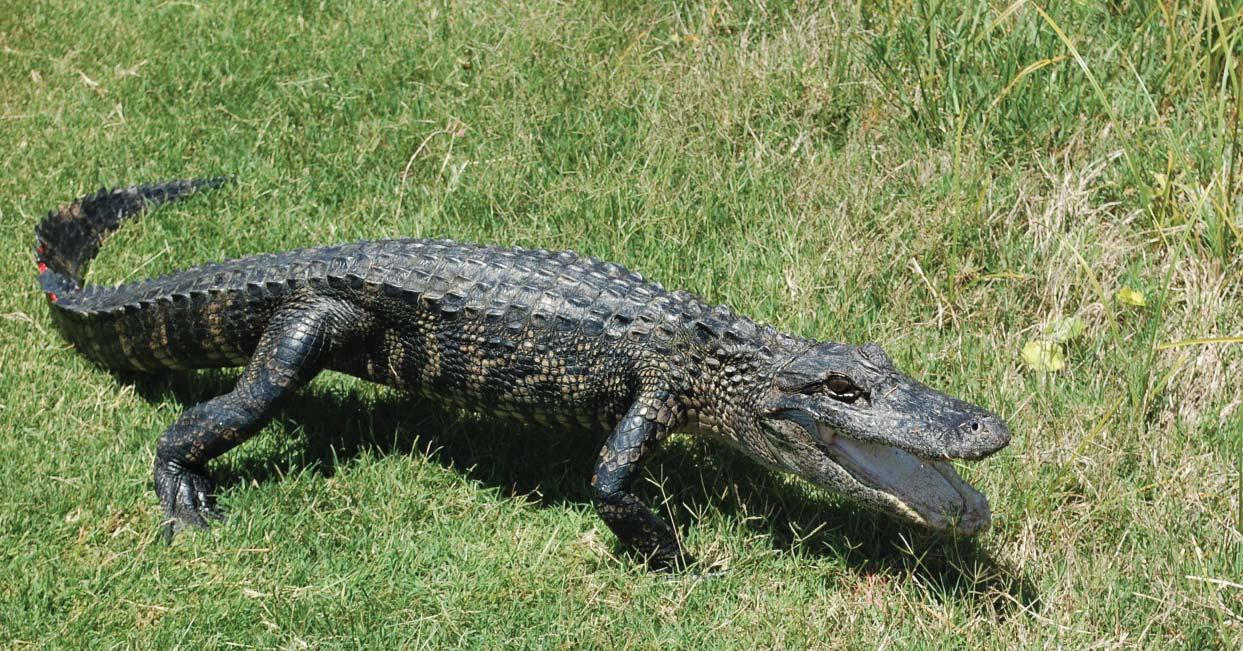
which comes off easily and doesn’t cause damage. The eyes were then covered to reduce the animal’s stress – not being able to see the activity going on or the people looming over it helps keep the gator calm.
With each capture, multiple measurements are taken, including the distance from the nostrils to the eyebrows, distance between the eyebrows, size of the head, size of the feet, body girth, and total length, from tip of the snout to tip of the tail. While these measurements are being taken, a tissue sample of the tail is taken, sex is determined, and if the animal is not already tagged, a tag is attached to the tail. Obvious wounds or scars are recorded as well.
When all data is collected and logged, the gator is positioned where it can easily return to the water, the eye covering is removed,
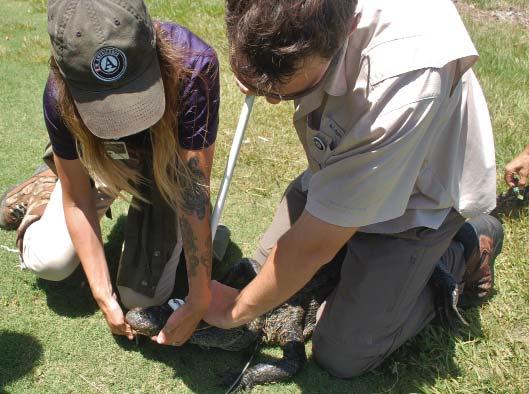
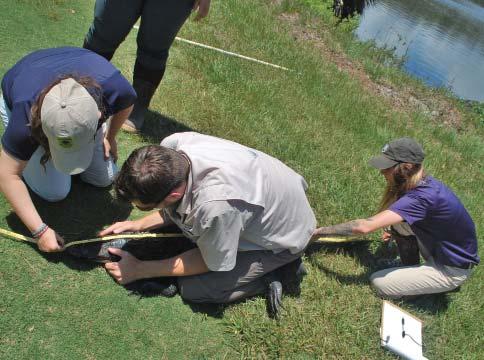
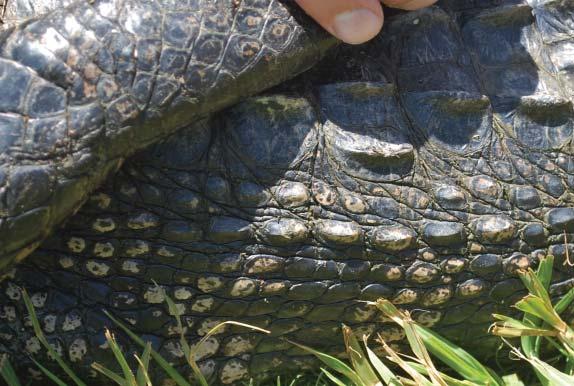
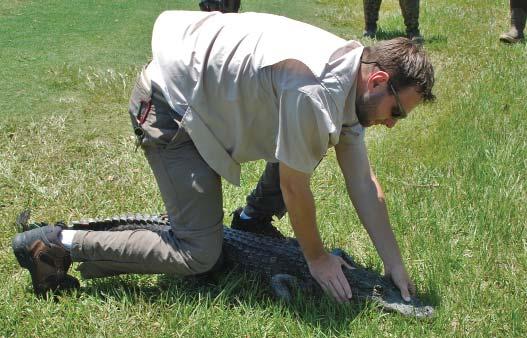
the tape around the mouth is removed, and the gator is released.
This fi rst gator was a six-foot, two-inch female and had already been tagged.
Female alligators, unlike many reptiles, actively care for their young. She will build a nest on land within easy reach of the water and lay her eggs. The nest doesn’t look much diff erent from a small pile of debris you might rake up in your yard after a hurricane. Pine straw, small sticks and leaves in a low-profi le mound that, unlike a similar mound in your yard, is nearly indistinguishable from the surrounding dense underbrush.
When the eggs near hatching time, the mother will check the nest at regular intervals by pressing down on it. When this
Opposite Page Top: A male gator, just over four feet long, making his was back to the water after being captured. Bottom: After snaring the gator and getting it on solid ground, a small noose is used to close its mouth. (L to R - Joseph Colbert, Michelle Watts, Yank Moore, Cailin Lutz, and Alec Jarboe)
This Page Top Left: While Alec holds the gator's head still, Cailin secures its mouth with electrical tape, which is easy to remove and doesn't harm the gator. The eyes are also covered to keep it calm. Left: Measurements are taken, including length overall. This gator measured six feet, two inches. Bottom Left: The alligator's thick hide is nearly impenetrable. The treble hooks used to snare the gators don't puncture their thick skin and leave no lasting damage. Above: Alec prepares to release the gator. The tape and eye covering have been removed and he gets his balance, preparing to move quickly away. Below: Free at last, she makes her way back to the water. Photos by Amy Thurman
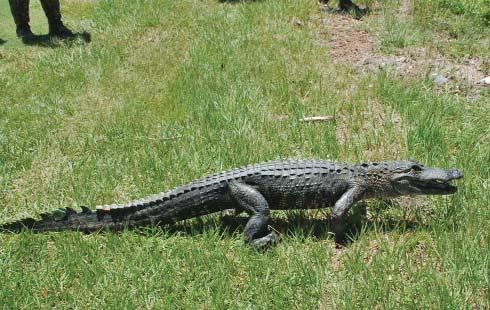
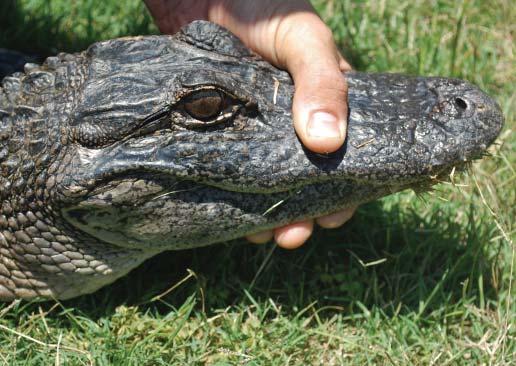
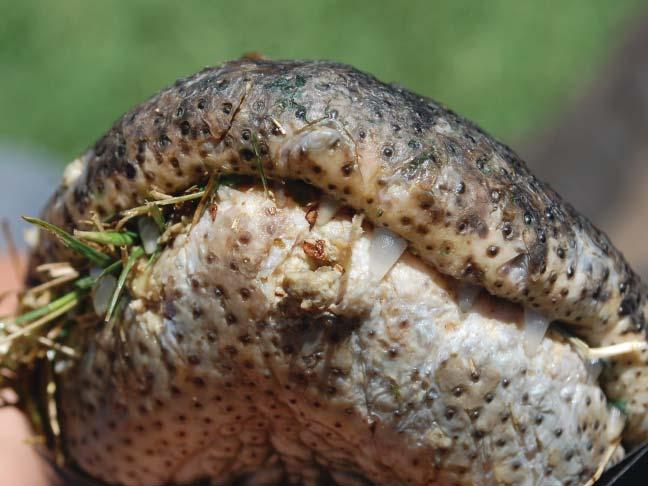
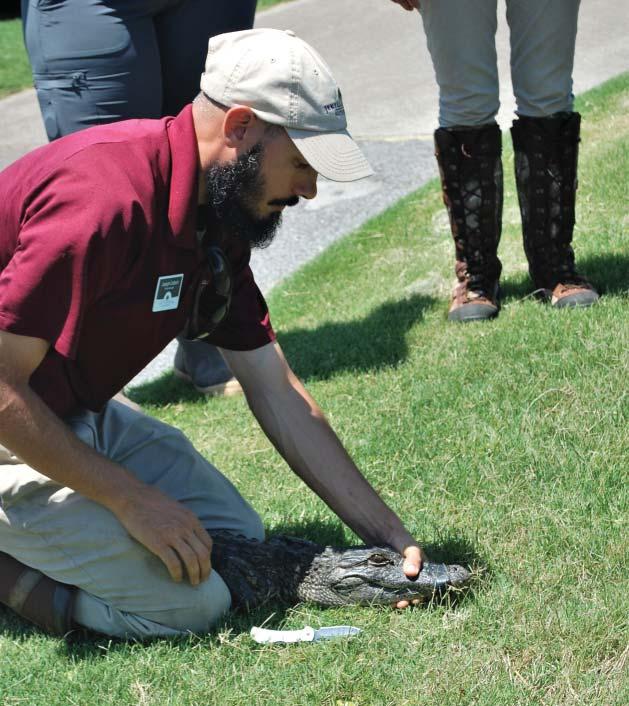
pressure provokes small chirps, she knows the time has come. She breaks open the eggs and carries her hatchlings to the water in her mouth. Baby alligators can remain in the mother’s nesting territory for as long as two to three years before she pushes them out to prevent them from eating their younger siblings.
“The chance of a hatchling making it to adulthood is comparable to a pawn making it across a chess board,” said Alec. Young hatchlings are frequently prey to wading birds, raccoons and snakes. If they make it through without being dinner, they still have to be wary of older males looking to rid themselves of competition.
Jekyll Island currently has a population of a little over 100 alligators in the three-foot or longer size range. (Smaller, therefore younger, gators are not included in this count due to their mortality rate.) This population count fl uctuates constantly as young alligators mature and are included in the count, or older males cull competitive younger males through fi ghting or running them off . In an average year there are three to fi ve nests on the island, each producing between 20 and 30 hatchlings.
It was mid-afternoon when we rode out to a pond, deep in the interior of the island. Bouncing along a dirt track through the maritime forest was like traveling back to a prehistoric time. We reached a secluded pond and picked our way through the undergrowth to a clearing at the pond’s edge, just as a light rain started to fall.
The team immediately spotted the snout and eyebrows of a gator, just within casting distance. After several failed casts, the alligator swam behind a small island at the center of the pond. Not to be defeated, Yank set out to the other side of the pond and in no time called out that he’d snagged the beast. We trekked through the underbrush along the perimeter of the pond until we found him, struggling to keep the gator on the line. It was huge and everyone’s adrenaline was rushing as we waited for it to tire enough that we could haul it up the steep, eight-foot bank to level ground.
When at last the moment came, it took all hands to get the huge reptile up the incline and three grown men to secure it. It seemed enormous on dry land, especially in comparison to the younger gators we’d caught earlier in the day, and this mature male measured in at nine feet, ten inches, overall. He had multiple battle scars and even the outline of a bite mark from another large gator on his tail.
When all data was recorded, and a tag was attached, he was maneuvered close to the edge of the bank facing the water, his eye covering was removed, the tape around his snout was removed (after everyone had moved back), and he was set free. Unlike the other gators the team had released that day, this warrior didn’t seem fazed by his capture. He rested in place for several long moments before standing and meandering to the edge of the incline, then made his way down and eased into the water. Rather
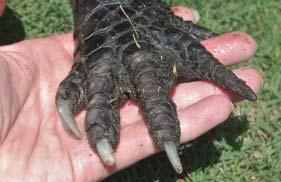
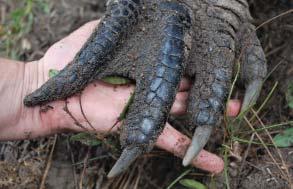
than diving to escape as the other gators had done, he slowly paddled across the surface of the pond, taking his time as if he didn’t have a care in the world, as we all watched.
“And now we’re going to call it a day,” Joseph said. “There’s no way we can top this!”
Opposite Page Top: A medium-sized male "teenager." Center: Close-up of a small gator's teeth. Bottom: Joseph prepares for release. Feet: The foot on the left is from a 6-foot 2-inch female, the foot on the right from a 9-foot 10-inch male.
This Page Top: It takes almost everyone to process this large male. (L to R - Maitland Bass, Michelle Watts, Rick Bauer, Joseph Colbert, and Alec Jarboe) Photo by Yank Moore Center: After his release, this large male turns and shows Alec his teeth before calmly making his way back to the water. Bottom : These large males, over nine feet, are important to the alligator population. “Medium-sized young males are like unruly teenagers,” Joseph explained. “They’re more likely to beg, more likely to make displays to people. The larger older males keep them in check.” Alligators are socially territorial, meaning the dominant male will only allow a limited number of other males in their ponds, to decrease the competition for resources, such space, food and mating females. If the pond becomes too crowded, the immature males will be forced to fi ght or fl ee to a diff erent source of fresh water. This natural order keeps the population in balance without assistance from humans.
Photos by Amy Thurman except where noted otherwise
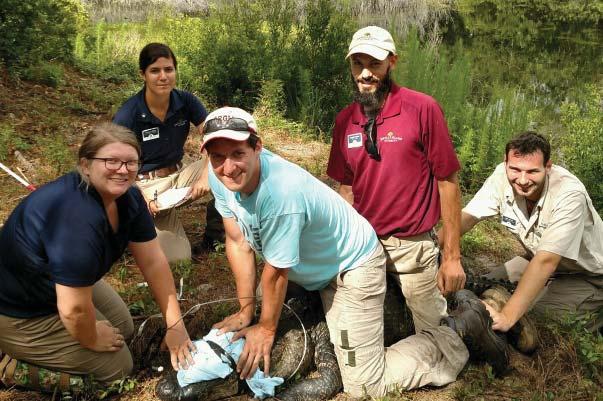
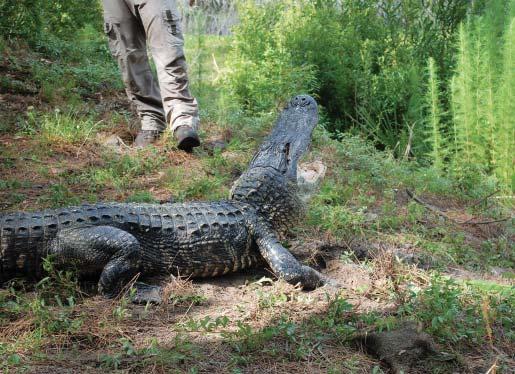
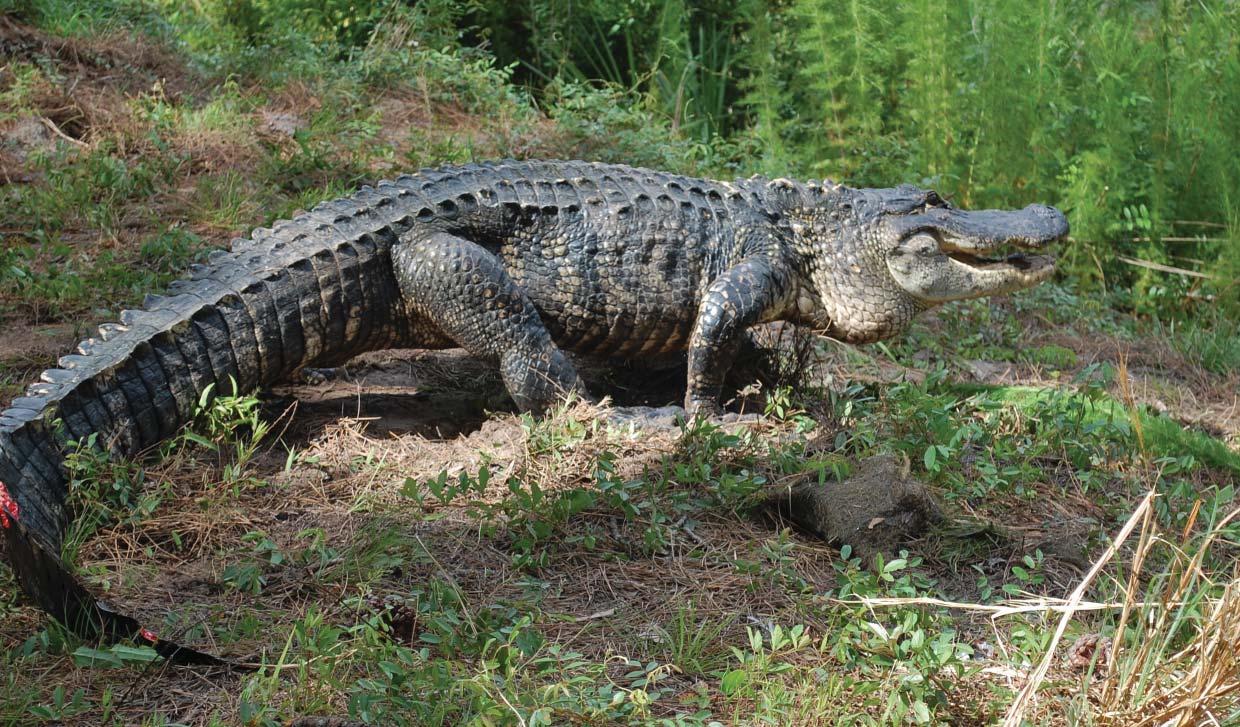
Call us. We’ll come get you!
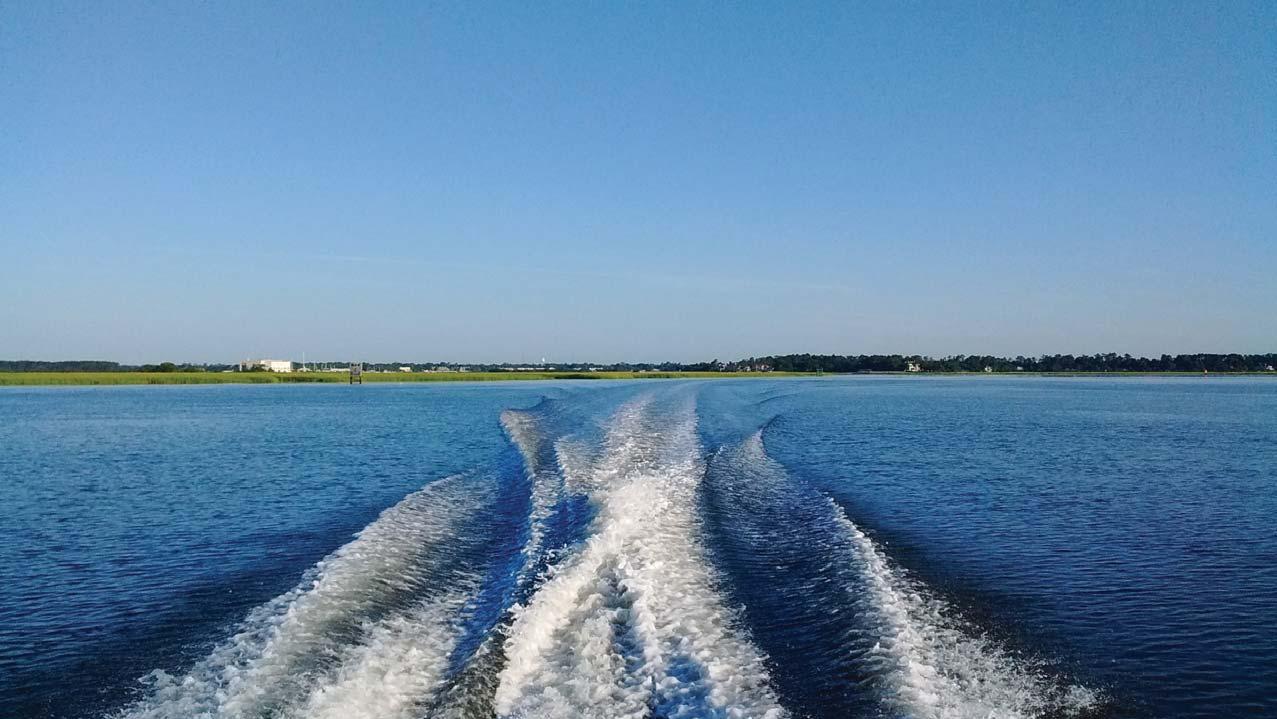
Serving Beaufort, Hilton Head, Savannah and St. Catherines Island
Service provides for ALL recreational boats you own, borrow or charter, anywhere in the world!
• Call your local tower for special signup discounts • Fast, experienced, and reliable service • BoatU.S. 24-hour dispatch services, call: 800-888-4869 • Towing service with ALL the benefits of membership in BoatU.S.
Towing • Soft Ungroundings Jump Starts • Fuel Delivery
For 24/7 Response, Call: 912-507-BOAT (2628)
$149 annual membership

